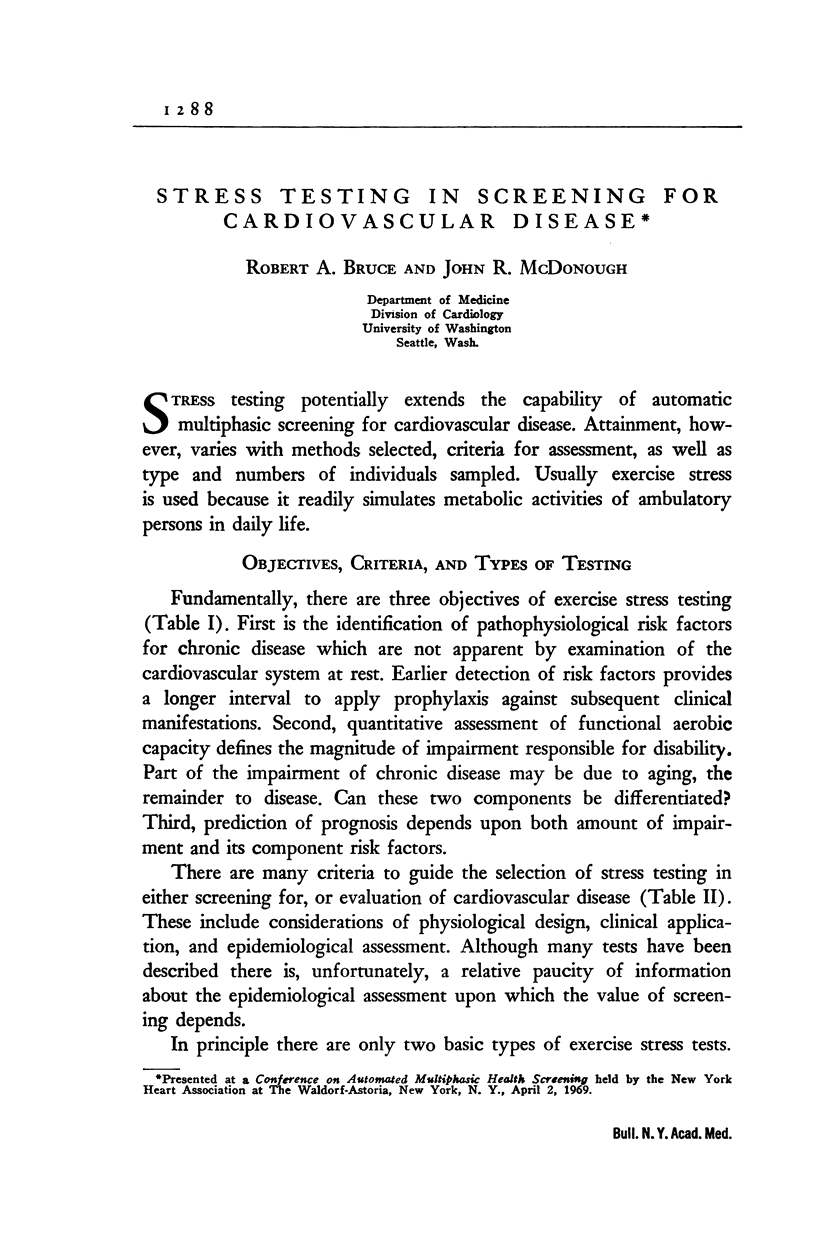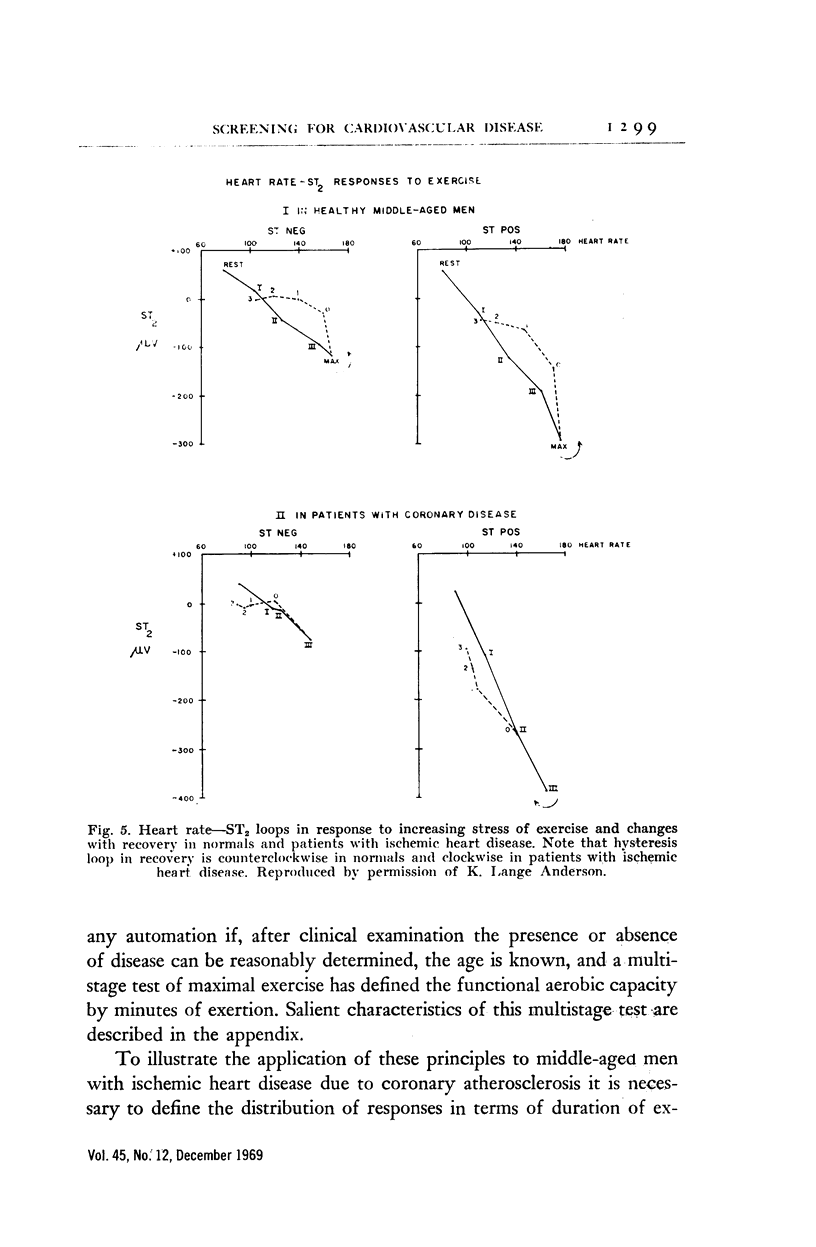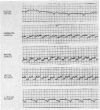Full text
PDF

















Images in this article
Selected References
These references are in PubMed. This may not be the complete list of references from this article.
- BRODY A. J. Master two-step exercise test in clinically unselected patients. J Am Med Assoc. 1959 Oct 31;171:1195–1198. doi: 10.1001/jama.1959.03010270031008. [DOI] [PubMed] [Google Scholar]
- Bruce R. A., Hornsten T. R., Blackmon J. R. Myocardial infarction after normal responses to maximal exercise. Circulation. 1968 Sep;38(3):552–558. doi: 10.1161/01.cir.38.3.552. [DOI] [PubMed] [Google Scholar]
- Bruce R. A., Mazzarella J. A., Jordan J. W., Jr, Green E. Quantitation of QRS and ST segment responses to exercise. Am Heart J. 1966 Apr;71(4):455–466. doi: 10.1016/0002-8703(66)90210-9. [DOI] [PubMed] [Google Scholar]
- DOAN A. E., PETERSON D. R., BLACKMON J. R., BRUCE R. A. MYOCARDIAL ISCHEMIA AFTER MAXIMAL EXERCISE IN HEALTHY MEN. A METHOD FOR DETECTING POTENTIAL CORONARY HEART DISEASE? Am Heart J. 1965 Jan;69:11–21. doi: 10.1016/0002-8703(65)90211-5. [DOI] [PubMed] [Google Scholar]
- Epstein F. H. Predicting coronary heart disease. JAMA. 1967 Sep 11;201(11):795–800. [PubMed] [Google Scholar]
- Hornsten T. R., Bruce R. A. Stress testing, safety precautions, and cardiovascular health. J Occup Med. 1968 Nov;10(11):640–648. doi: 10.1097/00043764-196811000-00003. [DOI] [PubMed] [Google Scholar]
- Kasser I. S., Bruce R. A. Comparative effects of aging and coronary heart disease on submaximal and maximal exercise. Circulation. 1969 Jun;39(6):759–774. doi: 10.1161/01.cir.39.6.759. [DOI] [PubMed] [Google Scholar]
- Li Y. B., Ting N., Chiang B. N., Alexander E. R., Bruce R. A., Grayston J. T. Electrocardiographic response to maximal exercise. Treadmill and double master exercise tests in middle-aged Chinese men. Am J Cardiol. 1967 Oct;20(4):541–548. doi: 10.1016/0002-9149(67)90032-x. [DOI] [PubMed] [Google Scholar]
- MASTER A. M., ROSENFELD I. The "two-step" exercise test brought up to date. N Y State J Med. 1961 Jun 1;61:1850–1858. [PubMed] [Google Scholar]
- MATTINGLY T. W. The postexercise electrocardiogram. Its value in the diagnosis and prognosis of coronary arterial disease. Am J Cardiol. 1962 Mar;9:395–409. doi: 10.1016/0002-9149(62)90157-1. [DOI] [PubMed] [Google Scholar]
- Mason R. E., Likar I., Biern R. O., Ross R. S. Multiple-lead exercise electrocardiography. Experience in 107 normal subjects and 67 patients with angina pectoris, and comparison with coronary cinearteriography in 84 patients. Circulation. 1967 Oct;36(4):517–525. doi: 10.1161/01.cir.36.4.517. [DOI] [PubMed] [Google Scholar]
- Mazzarella J. A., Bruce R. A., Green E. Off-line monitoring in ischemic heart disease. Circulation. 1966 May;33(5):719–726. doi: 10.1161/01.cir.33.5.719. [DOI] [PubMed] [Google Scholar]
- Most A. S., Hornsten T. R., Hofer V., Bruce R. A. Exercise ST changes in healthy men. Arch Intern Med. 1968 Mar;121(3):225–229. [PubMed] [Google Scholar]
- RUMBALL A., ACHESON E. D. Latent coronary heart disease detected by electrocardiogram before and after exercise. Br Med J. 1963 Feb 16;1(5328):423–428. doi: 10.1136/bmj.1.5328.423. [DOI] [PMC free article] [PubMed] [Google Scholar]
- Robb G. P., Marks H. H. Postexercise electrocardiogram in arteriosclerotic heart disease. Its value in diagnosis and prognosis. JAMA. 1967 Jun 12;200(11):918–926. [PubMed] [Google Scholar]
- Rowell L. B., Brengelmann G. L., Blackmon J. R., Bruce R. A., Murray J. A. Disparities between aortic and peripheral pulse pressures induced by upright exercise and vasomotor changes in man. Circulation. 1968 Jun;37(6):954–964. doi: 10.1161/01.cir.37.6.954. [DOI] [PubMed] [Google Scholar]
- SJOSTRAND T. The relationship between the heart frequency and the S-T level of the electrocardiogram. Acta Med Scand. 1950;138(3):201–210. [PubMed] [Google Scholar]
- TAKAHASHI H., IWATSUKA T., OHASHI I., HOTTA S. Some observations of the ST depression in the exercise electrocardiogram. Jpn Heart J. 1963 Mar;4:105–107. doi: 10.1536/ihj.4.105. [DOI] [PubMed] [Google Scholar]



